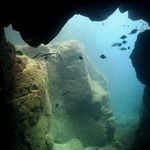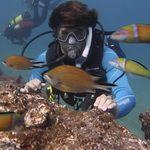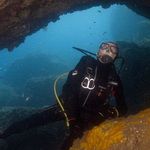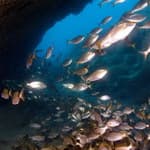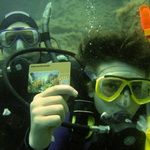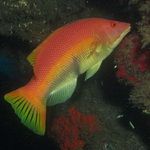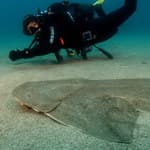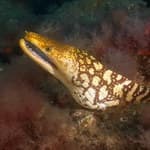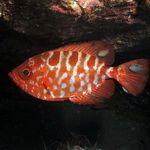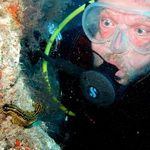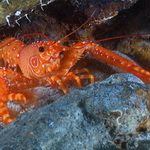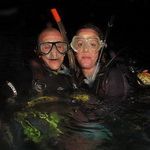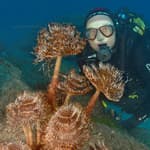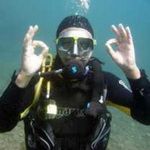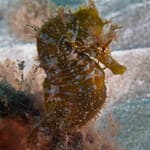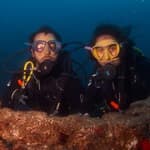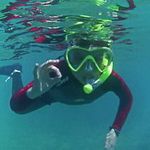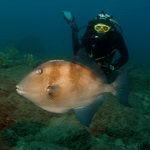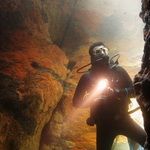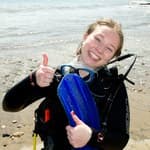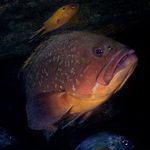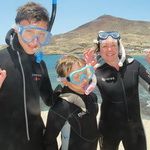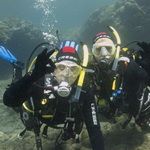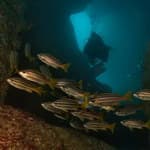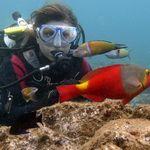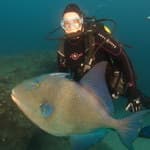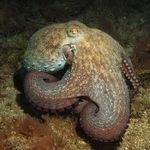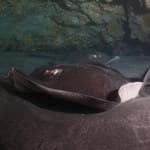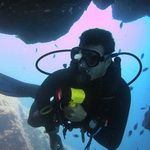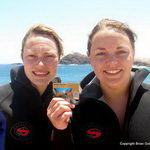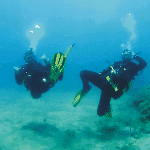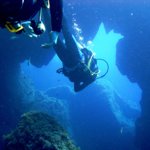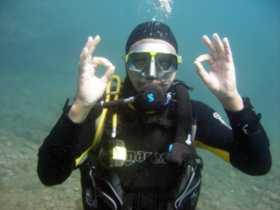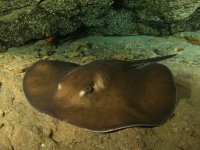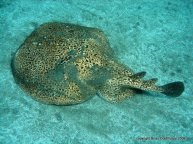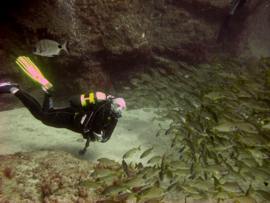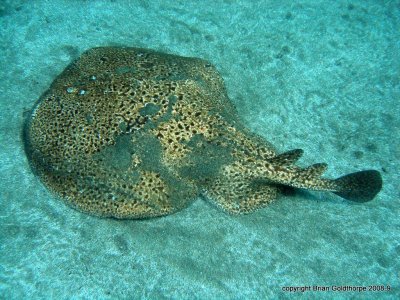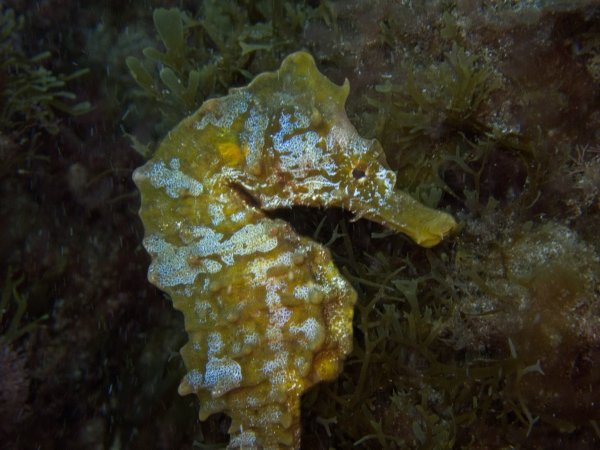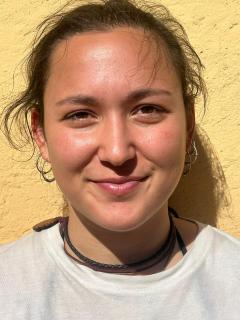Comparing Scuba Diving in the Canary Islands
with Scuba Diving in the Caribbean
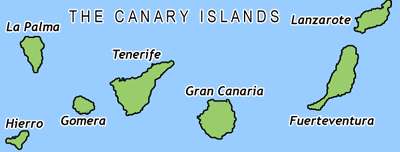
Following the devastating hurricanes that have destroyed much of the tourist infrastructure on the Islands of the Caribbean in summer 2017, several divers have asked us how diving in the Canary Islands compares with diving in popular Caribbean destinations such as the Bahamas, British Virgin Islands, and Turks and Caicos Islands.
There are just seven main islands in the group ranging from El Hierro in the west to Lanzarote in the East. It was from these islands that Christopher Columbus set off to discover the New World. The islands are volcanic in origin, and have excellent, western infrastucture and connections.
The Canaries are also an excellent place to dive all year round... not quite as warm or as vivid in colour as tropical destinations, but warmer and more prolific that the Mediterranean, with sharks, rays, turtles and wrecks and plenty of brightly coloured fish. The main diving areas are open for diving all year round and there are over 70 PADI dive Centres across the Islands.
Diving in the Canary Islands
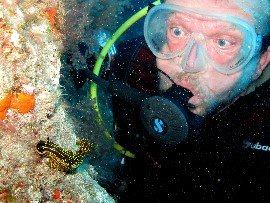
The first surprise is that the Canaries and many Florida Resorts are both as far South!. Two popular diving destinations, Tampa in Florida and Arinaga in Gran Canaria both sit at Latitude 27.85º.
Yet because of the geography surrounding both, the Canaries have a slightly cooler sub-tropical climate, while the Florida / Caribbean area have a warmer, Tropical climate. In summer the difference in water temperature is significant with temperatures up to 30ºC (86ºf) in the water in the Caribbean, while the Canaries reach a peak of about 24ºC (75ºf); In winter the difference is a bit more, with the Caribbean cooling to about 27ºC (80ºf) while the Canaries, warmed by the Gulf stream, drops to around 18ºC (54ºf) - but still warm enough to dive all year round in a wetsuit.
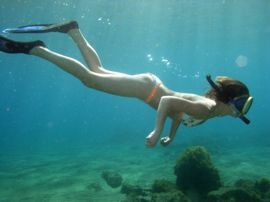
Secondly, many people think that as the Canaries are 'in the Eastern Atlantic' that they suffer from the same sort of stormy weather, icebergs and cold water that could be used as a backdrop for a remake of 'Titanic'.
The reality is that weather conditions are very stable in the Canaries, with high pressure from the 'Azores High' for much of the year and steady trade winds in summer. Just like the Caribbean, the Canaries can have odd stormy days, but we dive nearly every day of the year.
The Canaries have always been renown for their sunshine, and even in winter there will be
the chance to top up the tan on the non-diving days. Surface temperatures in the Caribbean
can sizzle at over 45ºC in summer, while in the Canaries a temperature of around
35ºC is more common, with the trade winds cooling the air. Las Palmas, the capital of
Gran Canaria is rated as having one of the world's best 'City' climates - not too hot
in summer yet comfortably warm in winter.
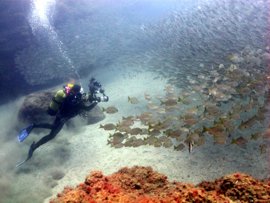
This difference is enough to restrict coral growth in the Canaries yet otherwise the diving conditions can be very similar, with good water clarity for most of the year in both areas. The Canary Islands have a range of colourful fish including parrotfish, wrasse, damselfish, glass-eyes and more, and if the Canary Islands lack the variety of the Caribbean, there are many species common to both areas, including lizardfish, goatfish, pufferfish, barracudas and moray eels which can be found in abundance here in the Canaries.
More of interest to divers, is that the volcanic seabed has many dramatic rock formations that can be a major attraction to diving in the Canaries. The volcanic rock has been eroded in many of our dive sites to create caves, swim-throughs and spectacular underwater arches. And if you like the dark it is easy to organise a night dive in the Canaries.
There are also several endemic species that bring in divers from all over the world to photograph them. The Canaries are one of the best places to see and photograph angel sharks (squatina squatina) and you should look out for the barred hogfish, cabrilla pintada 'painted face' and the bright yellow and quite rare variant of the island grouper, known as abade capitan.
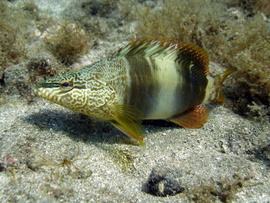
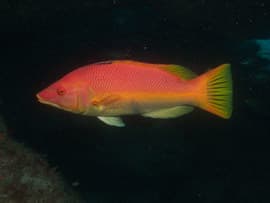
If you are bringing your camera to take underwater photos then there are plenty of colourful subjects, such as cleaner shrimps, tiger morays, glasseyes, parrotfish, damselfish and wrasse. Browse through some of the photos in our gallery of photos from the El Cabrón Marine Reserve and you may be surprised by the variety and colours you find here.

The Canaries are also a great place to see bigger species, such as angel sharks and rays.
There are five common species of rays (common, round, marbled electric, eagle and butterfly
ray) and occasional visits from rough-tailed, and bull rays, manta rays (in autumn) and
skate.
Another misconception is that diving in the Canaries is a bit like the Mediterranean.
Fortunately this is not the case, as the Canaries have not suffered from the over-fishing of
the Mediterranean, and are much warmer all year round than the Med. Diving in one of
the high-energy dive sites of the Canaries such as the El Cabrón Marine Reserve in
Arinaga is a very different experience to some of the relatively lifeless areas in the
Mediterranean.

Finally, if you are into wreck diving rather than reef, then Las Palmas in Gran Canaria has one of the best collections of diveable wrecks in the Atlantic. "The wrecks here are bigger and better than most Red Sea wrecks" is what one photo-journalist said when he did his first dive on the Arona outside Las Palmas.
So where are the best places to dive in the Canaries?
- El Hierro is one of the top locations, but it is also one of the most difficult to get to especially from Northern Europe. You have to fly to Tenerife then get a ferry to the Island.
- Gran Canaria is the most Southerly Island, and the El Cabrón Marine Reserve in Arinaga, is one hot-spot that is easy to get to, where you can regularly and safely see angel sharks in winter.
- Los Gigantes in Tenerife is famous for the stingrays, which some of the dive centres feed by hand
- Las Palmas on Gran Canaria has the biggest wrecks, including the Kalais, Arona and Frigorifica, and the 'Catedral' is a dive into huge underwater caverns that should not be missed.
- Puerto del Carmen in Lanzarote (the most northerly of the Islands) has several wrecks close to the harbour.
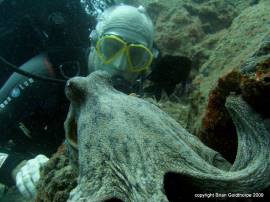
Octopus
|

Nudibranch
|
|
Hairy Blenny
|
Damselfish
|
Mr boyfriend and I are both Advanced Open Water divers, and as soon as our credentials and insurance were checked (as it should be!) we were off on 10 awesome and varied dives on the marine reserve and also in the north of the island in Sardina. As we are experienced in diving around the world, it was fantastic to know how safe and knowledgeable the team were - especially Ed and Brett! We really could not have asked for more. I highly recommend Davy Jones for their professionalism, experience and friendliness. I would most certainly return!
2016-07-12 Beth J Published by Tripadvisor.co.uk See full review
PADI Training Courses in the Canary Islands
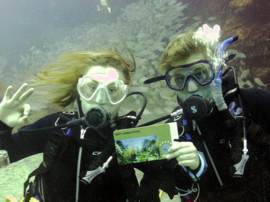
When it comes to diver training, there is little to choose in terms of facilities and structure between the Canary Islands and the Caribbean. Both have long established, professional training schools, which are regulated by their governments to achieve high standards of safe training. There are schools which cover PADI, BSAC, CMAS, ACUC and several other training brands throughout the Canaries. Particularly for those looking to fit in a course quickly, the ability to vary flight days can mean that you do not need to spend a full week away to get a qualification that is done in two or three days. Diving hot-spots such as the El Cabrón Marine Reserve make an excellent place to take courses such as the PADI Open Water Course because you get to see lots of interesting marine life such as cuttlefish, arrowhead crabs, octopus, trumpetfish, parrotfish, damselfish, wrasse and much more on all the training dives. We run courses all year round in the El Cabrón Marine Reserve so there are no restrictions on when you can do your course.
Canary Islands for Families?
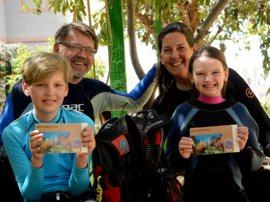
There is a huge range of accommodation in the Canaries from simple apartments to five star luxury. The Spanish Canary Islands offers options such as theme parks, carnivals, concerts, unrestricted travel, car hire and diversity.
Summary
If you want a good dive destination in the Northern Hemisphere then perhaps you should
come and try the Canaries. The Canaries have much more variety of diving than the
Mediterranean, as well as warmer seas. If you are looking for a short 'winter sun' break with
a couple of days diving, or perhaps a family holiday where diving is just part of the mix,
then the Canary Islands have many advantages.
When you take into account the ease and frequency of flights to the Canaries; low-cost
flights from Ryanair and others; Euro pricing and currency and good technology support and
infrastructure; then the Canaries can make a great place for a 'long diving weekend' or mixed
activity trip.
Still got questions about diving in the Canaries? Please do not hesitate to contact us and we will be happy to help!.
NO Deposit, Cancellation or Change fees!

